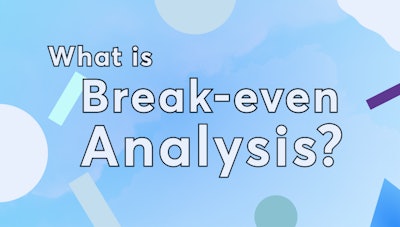
There are so many small businesses, and each one is as unique as the person behind it. But one thing that unites them all is a need to turn a profit. Unless you’re already sitting on mountains of cash, it’s tough to make a solid go of it if you’re spending more money than you’re bringing in.
For small business owners, knowing when your business will become profitable is vital. It helps you mitigate risk, make more informed business decisions and plans, and if you’re planning to secure outside funding, it’s a key component of pitching investors and lenders.
To figure that out, you need to conduct a break-even analysis. Below, we’ll cover:
- What break-even analysis is
- Why it’s important for small businesses
- How to calculate your break-even point using the break-even analysis formula
- The limitations of break-even analysis
What is break-even analysis?
Break-even analysis is a financial calculation that helps business owners identify how long it will take for a company, product, or service to become profitable. In other words, the formula tells you when you’ll be able to recoup any upfront costs and investments, and begin to profit.
Using the break-even analysis formula, you can develop a concrete understanding of how many products/hours/units of service you’ll need to sell in order to put your business in the black.
当你应该做一个盈亏平衡分析吗?Business.comlists three scenarios:
- Expanding your business:Before you open a new location or add new offerings, it’s important to know how long it will take the investment to turn a profit. Break-even analysis allows you to understand your financial position and make adjustments before you make a final decision.
- Lowering your pricing:Businesses often lower their prices to beat out competitors and draw in new customers. However, if prices are lowered so far that they prevent a profit from being made, the move will actually harm your business. Break-even analysis helps you identify your pricing flexibility and avoid losses.
- Narrowing down your options:Running any kind of business involves making constant changes. Whether it’s responding to market forces or internal adjustments, break-even analysis is a valuable tool in making informed, data-driven decisions.
Why is break-even analysis important?
Simply put, break-even analysis is important because it forces business owners to think about profit before doing things like launching a business, creating a new product line, moving from ecommerce to brick-and-mortar, etc. The framework provided by break-even analysis can also help you work through key decisions you’ll need to make during these situations.
Here are a few other benefits of break-even analysis:
- Logistics:Break-even analysis helps you determine pricing for your products and services. It can help you identify costs, how long you can afford to go before your break-even point, and the amount of materials you can afford. From there, you can easily land on a price that makes the new venture viable—allowing you to cover costs and continue operating long enough to turn a profit.
- Goal-setting and planning:When you know your break-even and profit points, you can set better, more realistic and useful targets for revenue, profit, and more. Plus, long-term planning becomes easier and more accurate.
- Expense tracking:When you’re planning a new business or product, it can be easy to miss key expenses and costs. Conducting a break-even analysis forces you to think through all the financial requirements and ramifications beforehand, so nothing falls through the cracks.
- Securing funding and investment:Break-even analysis is a key component of yourbusiness plan—one that every potential investor and lender will want to see before making a decision on whether to invest in or loan to you.
- Helping make decisions:When you’re deciding whether or not to start a business or launch a new product, it can be hard to make that decision without taking emotion into account. Break-even analysis gives you a concrete, mathematical way to gauge the viability of that decision.
The break-even analysis formula and how to calculate it
Before we dive into the break-even analysis formula and how to use it, let’s talk about the information you need to have at the ready. To calculate your break-even point, you need to know:
- All the fixed costs associated with the new venture, product, sales channel, etc.
- Any variable costs
- The price you plan to charge (Note: This isn’t set in stone—think of it as a starting point that you can alter as needed based on the results of the break-even analysis.)
Fixed costs are expenses that remain the same regardless of how many products you sell or services you provide. They may include things like:
- Rent, mortgage, and property taxes
- Software subscriptions
- Insurance
- Employee salaries
Variable costs, on the other hand, change as your volume increases and decreases. These may include, among other expenses:
- Materials and inventory
- Utilities
- Variable employee pay (i.e. part-time and other hourly employees, contractors, etc.)
Once you have these numbers handy, total up all of the fixed costs into one bucket and all the variable costs into a second bucket.
Now, you’re ready to calculate your break-even point. Here’s the formula:
Break-even point = Fixed costs / (Price – Variable costs)
The last step is to calculate your break-even point using the formula, thenadjust your pricing or costsuntil you reach a break-even point you (and any stakeholders) are comfortable with.
Break-even analysis example
Now that we’ve covered the theory, let’s see it in action.
Brian is thinking of starting a t-shirt business and wants to understand whether this new venture is viable. Below are Brian’s expected costs and pricing details for each unit (read: t-shirt).
- Fixed costs (including workshop rent, Brian’s salary, insurance, and subscriptions):$7,000
- Variable costs (including inventory and delivery driver pay):$8
- Price:12美元per t-shirt
Note:Costs are calculated monthly.
The break-even formula for Brian’s proposed venture looks like this:
$7,000 / ($12 – $8) = 1,750 t-shirts
Based on that, the business needs to sell 1,750 t-shirts per month in order to turn a profit. From here, Brian can decide whether that volume is feasible or not. If not, Brian can tweak his costs and pricing to reach a break-even point that works for the business.
Disadvantages of break-even analysis
Calculating your break-even point is a vital step in determining the viability of any new venture—be it a brand new business, new sales channel, or new product or service line.
That said, there are some limitations to relying entirely on break-even analysis in your decision-making.
The break-even formula can’t account for everything
Break-even analysiswon’ttell you if there’s demand for your business in the market. It can’t tell you whether your break-even units are realistic or the timeframe it will take to get there. These are all judgments you need to make for your own business, based on market research and other data.
Things get complicated if you have multiple products, services, or lines of business
只要你出售多种产品或服务,哟ur costs and pricing will likely vary across them. That means you need to calculate separate break-even points for each type of product, then meld those numbers together to find your overall break-even point. Even with just two products, that process can get complicated.
The formula is much simpler than real-life markets
Break-even analysis is a useful practice, but it’s just that: practice. The results of your break-even analysis don’t take many aspects of real-life into account. Things like competitors in the market, inflation, cost changes over time, and market demand will all affect the prices you can charge and the units you can move—and they aren’t reflected in your break-even formula.
When will your business break even?
Despite the limitations, break-even analysis is a vital exercise for every business. Whether you’re starting a new business from the ground up or launching your tenth product line, it’s important to understand where you break-even point lies and how you can tweak it.
And when you’re ready to start that business,Wave Moneyhas you covered with everything you need to manage your finances. From free banking to invoicing to accounting, it’s an easy way to save time and money while understanding your finances better than ever.





















